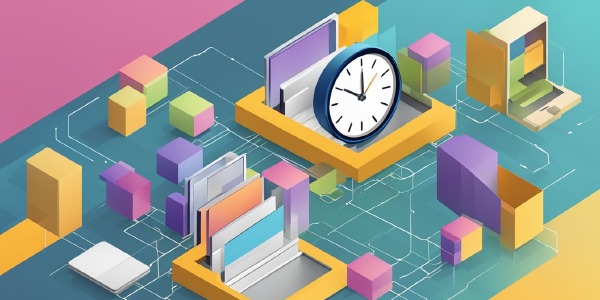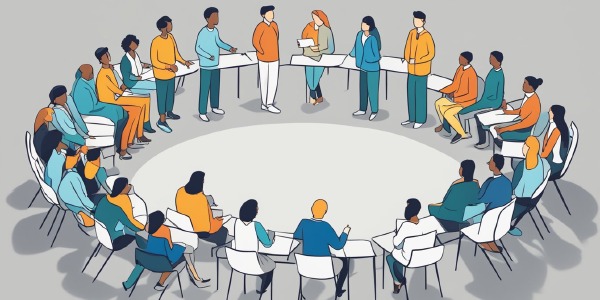The Science of Neuroplasticity: Unlocking the Secrets of Lifelong Learning
Neuroplasticity, the brain’s remarkable ability to reorganize itself by forming new neuronal connections throughout a person’s life, stands as the cornerstone of lifelong learning.
This ability allows the brain to compensate for injury and disease, to adjust to new experiences, and to incorporate learning and memory.
At the core of lifelong learning, neuroplasticity challenges the once-held belief that the brain’s structure is static after a certain period of growth. Instead, it proposes that our brains are malleable and can continue to change and adapt as we engage with new knowledge, skills, and experiences.

Understanding how neuroplasticity operates is vital for anyone interested in personal development or recovery from neurological conditions.
It encompasses not just the biological processes that reshape our neural pathways but also the environmental and emotional factors that influence this transformation.
By realizing the factors that enhance or inhibit neuroplasticity, individuals can adopt strategies that promote cognitive flexibility, personal growth, and skill acquisition across their lifespan.
Key Takeaways
- Neuroplasticity underpins the brain’s ability to learn and adapt throughout life.
- The brain remains malleable and responsive to new learning experiences and environments.
- Recognizing the factors influencing neuroplasticity can help enhance lifelong learning and development.
Fundamentals of Neuroplasticity

Your brain undergoes constant change, adapting as you learn and experience new things. Neuroplasticity is at the heart of this adaptability, shaping your brain’s neural pathways throughout life.
Defining Neuroplasticity
Neuroplasticity, or brain plasticity, is the ability of your brain to reorganize synaptic connections in response to learning or after injury. It is fundamental to your brain’s development, learning processes, and recovery.
Neurons and Synapses
Neurons are specialized cells in your brain that transmit information. Synapses are the tiny gaps between neurons where signals are passed. Together, they form neuronal networks that underpin cognition and function.
- Neurons: The building blocks of the brain.
- Synapses: Connections between neurons that facilitate communication.
Types of Neuroplasticity
Functional Plasticity: The brain’s ability to move functions from a
damaged area to undamaged areas.
Structural Plasticity: The brain’s ability to physically change its
structure in response to learning and experience.
Principles of Brain Plasticity
- Use it or lose it: Skills and connections not routinely used are pruned.
- Use it and improve it: Tasks practiced often lead to stronger synaptic connections.
These principles highlight the importance of engaging in stimulative activities to enhance your cognitive abilities.
Critical and Sensitive Periods
Certain times in life, particularly early developmental stages, are considered critical periods where the brain is exceptionally plastic.
Sensitive periods, on the other hand, are extended phases where your experiences heavily influence brain development.
- Critical periods: Windows of extreme neuroplasticity, essential for certain developmental milestones.
- Sensitive periods: Times when the brain is more responsive to learning new skills or habits.
Plasticity Regulators and Inhibitors
Your brain contains factors that can either promote or inhibit plasticity:
- Regulators: Neurochemicals and growth factors that enhance plasticity.
- Inhibitors: Signals or structures that reduce plasticity, which may protect the stability of existing networks.
Understanding these elements helps in developing strategies to enhance brain function and rehabilitation.
Neuroplasticity Across the Lifespan

Your brain’s ability to reorganize and form new neural connections throughout life is a cornerstone of neuroplasticity. This process allows you to learn from and adapt to different experiences, emphasizing the dynamic nature of your brain as you age.
Early Development
During your early years, neuroplasticity is particularly vibrant.
From birth to early adulthood, your brain undergoes rapid growth in gray matter, which is densely packed with neuron cell bodies and plays a crucial role in neurodevelopment. This period is characterized by:
- An overabundance of neural connections, gradually pruned to increase efficiency.
- Heightened sensitivity to environmental stimuli and experiences.
- Critical periods where certain skills and knowledge are more easily acquired.
Developmental disorders may occur when these processes are disrupted, with potential lifelong effects.
Adulthood and Aging
As you advance into adulthood, neuroplasticity continues but shifts focus. In the adult brain, plasticity is more about refining the network that’s already in place rather than creating abundance. Key points include:
- Experience-dependent plasticity becomes paramount, with new skills and information slowly reshaping neural pathways.
- Although cognitive decline associated with aging can affect plasticity, your brain maintains the ability to adapt and rewire to some extent.
- Prior knowledge and a lifetime of experiences interact with new learning, influencing how effectively your brain can adjust and accommodate new information.
The role of experience
Your experiences dictate how neuroplasticity will unfold over your lifespan. Consider these points:
- Positive experiences, like learning new skills, social interactions, and physical exercise, tend to promote healthy plasticity and cognitive maintenance.
- Conversely, negative experiences, such as chronic stress or lack of stimulation, may hinder your brain’s plastic capacity.
- Continuous learning and challenge are critical for promoting plasticity and may help mitigate age-related declines.
Factors Influencing Neuroplasticity

Neuroplasticity, your brain’s remarkable ability to reorganize and adapt, is influenced by various factors. Knowing how these factors impact brain health can empower you to enhance your cognitive development and lifelong learning.
The Impact of Learning and Education
Learning ignites neuroplasticity by encouraging the creation of new neural pathways.
Education provides structured opportunities to engage your brain, supporting cognitive development.
Consistent mental stimulation through puzzles, language learning, or studying new subjects can strengthen neural connections.
- Attention and Motivation: When you’re motivated and pay attention, your brain is more likely to undergo plastic changes. Learning environments that keep you engaged promote better retention and skill acquisition.
- Adult Learning: The notion that you can’t teach an old dog new tricks is outdated. Adult learning stimulates neuroplasticity similarly to learning earlier in life, with the capability to grow and adapt.
Physical Exercise and Brain Health
Physical exercise benefits your brain health, bolstering neuroplasticity.
Regular exercise, especially aerobic, increases oxygen supply to the brain and can help in creating more neural connections.
- Support for Cognitive Development: Engaging in activities like cycling or jogging for at least 150 minutes per week can enhance cognitive function and brain plasticity.
- Exercise: Incorporating variety in your exercise routine can stimulate different areas of the brain, supporting overall brain health and resilience.
Diet, Sleep, and Stress
What you eat, how well you sleep, and your stress levels all affect brain plasticity.
- Diet: A balanced diet rich in omega-3 fatty acids supports brain cell health and cognitive functions.
- Sleep: Quality sleep is crucial for consolidating learning and memory—key processes in neuroplasticity.
- Stress: Conversely, chronic stress can impair your brain’s plasticity. Stress management techniques like mindfulness or yoga can mitigate these effects.
Environmental and Social Factors
Your surroundings and social relationships shape your brain’s plasticity.
Stimulating environments and positive social experiences provide sensory and cognitive input essential for neuroplasticity.
Environment: A dynamic environment with varying stimuli can boost your neuroplastic potential.
Social Experience: Engaging in social activities and new experiences can also support brain health and cognitive development.
Neuroplasticity in Action

Neuroplasticity showcases the brain’s potential to change and adapt through different stages of life. Your experiences, education, and attention to cognitive training shape this remarkable phenomenon.
Memory Formation and Retrieval
Your ability to form and retrieve memories is a dynamic functionality of your brain.
It heavily relies on a process called long-term potentiation, enhancing the connection between neurons with repeated use.
This means that your hippocampus, a vital component for memory formation, becomes more efficient through retrieval practice and attention, thus reinforcing memory retention.
For instance, when you learn a new language, the consistent practice allows your working memory and long-term memory to collaboratively store and recall the new vocabulary and grammar rules.
Extensive Learning and Brain Structures
Consistent and extensive learning can lead to anatomical changes in the brain.
For example, when you dedicate considerable effort to mastering a musical instrument, you alter the size and connectivity of the cerebral cortex areas involved in processing music and coordinating fine motor skills.
Structural changes also occur in the hippocampus as you solidify and integrate new information into your memories, allowing for quicker retrieval and better application in various contexts.
Such extensive learning experiences illustrate how dedicated education and practice can lead to lasting changes in your brain’s architecture.
Neuroscientific Research and Insights

Your brain’s ability to adapt and grow is at the forefront of neuroscientific research, revealing invaluable insights into how you learn throughout your life.
Neuroimaging and Brain Mapping
Through neuroimaging technologies like fMRI (functional Magnetic Resonance Imaging) and PET (Positron Emission Tomography), scientists can observe your brain’s activity in real time.
They’ve found that learning new skills increases grey matter and cortical thickness in related brain regions, showing that your brain’s structure is adaptable at any age.
Meta-Analysis of Neuroplasticity Studies
A meta-analysis of neuroplasticity research consolidates findings from various studies, quantifying the impact of learning on the brain.
These analyses underscore the fact that engaging in education and complex tasks can result in measurable changes in brain structure, particularly in areas associated with cognition and memory.
Cognitive Reserve and Plasticity
Cognitive reserve refers to your brain’s resilience to damage.
It is thought that a higher cognitive reserve, which can be bolstered by lifelong learning and brain training, may help you maintain mental functions in the face of aging.
Brain reserve is also an important aspect, indicating your brain’s innate capacity to form new neural connections.
Emerging Trends in Neuroplasticity Research
The field of educational neuroscience is a burgeoning area focusing on applying insights from brain science to improve teaching methods.
Current trends point towards personalized learning experiences tailored to your unique neurological profile, enhancing your ability to learn and retain information effectively.
Challenges and Considerations

As we consider the potential of neuroplasticity in lifelong learning, it’s crucial to recognize that it’s not an unmitigated positive force. There are challenges and considerations that range from its connection to psychiatric disorders to limitations in neural adaptability, alongside ethical questions and the horizon of personalized medicine.
Neuroplasticity and Psychiatric Disorders
Experience-dependent plasticity shapes your brain’s structure and function through learning and sensory experience.
However, plasticity can also be a contributing factor to psychiatric disorders. Anomalies in plasticity regulators may lead to, or exacerbate, conditions such as depression, PTSD, or schizophrenia.
Limitations of Neural Plasticity
Neural plasticity isn’t unlimited. Your brain’s capacity for change is influenced by age, with critical periods in childhood where it shows higher adaptability.
Beyond these periods, plasticity may decrease, making learning more challenging. Additionally, some brain injuries can impair plasticity, adding complexity to rehabilitation efforts.
- Age-Related Decline: Neural adaptability diminishes with age.
- Injury and Disease: Certain injuries and diseases can impede neural plasticity.
Ethical Issues in Neuroscientific Advancements
With advancements in understanding neural plasticity, ethical concerns emerge.
Consider neuromodulatory systems that could be manipulated to enhance cognitive abilities—this could result in inequities in access and potential coercion in educational or employment contexts.
Decisions about who and how to treat with emerging neuroscientific interventions require careful contemplation.
- Access to Treatments: Not everyone has equal access to neuroscientific advancements.
- Potential for Coercion: Risks of pressure to undergo cognitive enhancement.
Future Directions and Personalized Medicine
Finally, turning towards the future, promising personalized translational strategies are on the rise.
These approaches consider individual differences in plasticity and neuromodulatory systems to create targeted interventions.
Stay informed on how these developments may offer tailored solutions for education and treatment of psychiatric disorders, truly harnessing the potential of personalized medicine in the realm of neural plasticity.
| Advancements | Impact on Personalized Medicine |
|---|---|
| Enhanced imaging | Improved diagnosis and treatment planning |
| Genetic profiling | Identification of plasticity regulators for tailored therapy |
Applications in Lifelong Learning and Development

Neuroplasticity plays a crucial role in shaping your ability to learn and adapt throughout your life. It impacts how you acquire skills, knowledge, and even adapt to new technologies and methodologies in your personal and professional life.
Influences on Lifelong Learning
Your brain continues to grow and change as you encounter new experiences and challenges.
Lifelong learning is shaped by cognitive development, which is significantly influenced by neuroplasticity.
This means that as you engage in new learning activities, your neural pathways adapt to support the acquisition and retention of knowledge.
Motivation is a key driver that influences your desire to pursue education and learning, and your prior experiences also play into how you learn and process information.
Lifelong Learning and the Workforce
In today’s rapidly evolving job market, continuous learning is essential.
With automation transforming industries, your ability to adapt to new technologies through learning is paramount.
This adaptability is a direct manifestation of neuroplasticity. By engaging in lifelong learning, you can maintain a competitive edge in the workforce, as your cognitive flexibility allows you to acquire new skills and assimilate novel ideas.
Cognition and Literacy in Adult Education
Adult education often focuses on improving literacy and cognitive skills.
Through consistent engagement with educational content and cognitive training, you can improve functions like memory, problem-solving, and critical thinking.
This enhancement in cognitive abilities is supported by your brain’s ability to rewire itself in response to learning, which is especially important in adult learning where flexibility and the capacity to synthesize new information are needed.
Technological Impact on Learning
Technology has revolutionized the way you learn, providing access to a wealth of information at your fingertips.
Digital platforms and video games offer interactive experiences that can result in positive sensory experiences, further encouraging neuroplastic changes.
These changes facilitate better retention of information and improved cognitive development as you engage with varied types of learning materials.
Neuroplasticity Training Tools and Methods
There is a range of tools and methods available that support neuroplasticity and cognitive training. These include:
- Brain training apps: Structured activities designed to enhance certain cognitive skills.
- Mindfulness practices: Techniques like meditation can improve your attention and mental control.
- Physical exercise: Regular physical activity has been shown to support neurogenesis and overall brain health.
- Skill learning: Taking up new hobbies or learning new languages can stimulate brain growth and connectivity.
Conclusion

Neuroplasticity has shown you that your brain can adapt and change throughout your lifetime.
With each new skill you acquire and information you learn, your brain’s neural networks are actively remodeling themselves.
This means that lifelong learning is not just a concept; it’s a biological process that’s supported by the plasticity of your neurons.
You play a pivotal role in fostering your own neuroplasticity.
Through activities like:
- Learning new languages
- Playing a musical instrument
- Engaging with complex problem-solving tasks
…you are encouraging your neurons to forge new connections, which can lead to improved cognitive abilities.
Keep in mind these key takeaways:
- Your brain’s ability to rewire itself is most active during childhood but continues throughout adulthood.
- Neural pathways strengthen with practice, so consistency is crucial for learning.
- Variability in learning experiences can enhance neuroplasticity.
Continue to challenge your mind, embrace novel experiences, and prioritize activities that push your cognitive boundaries.
By doing so, you’re not only enriching your own life but also keeping your brain in a state of active growth and resilience.
Remember, the pursuit of knowledge is a lifelong adventure that keeps your neurons agile!




